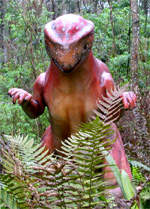
March 22, 2008

A major conclusion from my “Pinky Expedition” is the same one that I have found over and over again. There are no simple answers to the mysteries of monsters in our midst. Looking at other “cryptids,” additionally, we have to consider the other pieces of the puzzle.
The long-term sightings of strange creatures from the St. Johns River, Lake Monroe, and surrounding areas, from the 19th century, during the mid-20th century, and at other times, appear to involve many varied cryptids.
Bipedal dinosaurs, sauropods, traditional long-necks, and big blobs in the water have all been descriptions for the St. Johns River Monster, the Lake Monroe Monster, and Pinky. Clearly, some people unfamiliar with the local alligators and manatees have seen things in the water that startled them, and have come away with monster tales. Misidentifications must be part of the picture.
But what of the land-based sightings by locals of more dinosaurian cryptids? What are we to make of them? They are not easily addressed by an alligator knocking at our door.
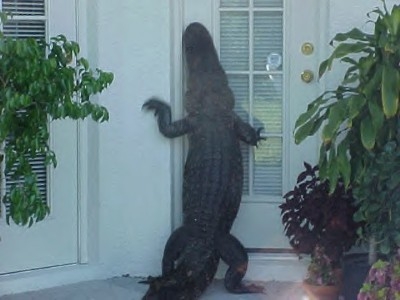
Besides other Florida freshwater monsters, especially ones seen in the similar Suwannee River System, the links to the St. Johns River cryptids may be as close as things reported from nearby states’ wetlands. Looking to Lake Norman’s “Normie” in North Carolina, and Lake Murray’s “Messie” in South Carolina, may give clues to the identity of the St. Johns’ Pinky and the Lake Monroe Monster.
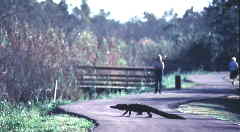
More, however, has been researched in the recent past on one specific watery cryptid of the area, Altamaha-ha, said to inhabit the coastal waterways of Georgia’s tidal marshes.
Past children’s book authors and specifically cryptofiction novelist Dallas (or D. L.) Tanner have been drawn to the folklore and tales of the creatures seen along the Altamaha River, below Savannah, Georgia.
Tanner has written of the cryptid, thusly:
For the last forty years…the Altamaha-ha has been sighted basking itself on the shore, trolling casually along the river in plain sight of eyewitnesses, and even reacted defensively to the presence of boaters.
Perhaps I should begin with a brief description of the river itself. The second largest river basin in the United States, second only to the Mississippi, it extends some 137 miles before joining up with its three major tributaries. These include the confluence of the Ocmulgee and Oconee rivers near Lumberton City, and joined further downriver by the Ohoopee. Where it empties out into Altamaha Sound above Brunswick, it is joined by the Darien, Butler and Champney rivers.
All of these tributaries and secondary rivers have reported sightings of the creature also known as the Alty. The Altamaha is home to over 50,000 species of migratory and non-migratory birds, as well as manatees, sturgeon and alligators. In fact, it is known as ‘The Little Amazon,’ due to the plethora of wildlife and the diversity of its ecology and topography.
What I notice in Tanner’s vision and location of the beast is a cryptozoological answer to what could explain some of the Lake Monroe and St. Johns River sightings.
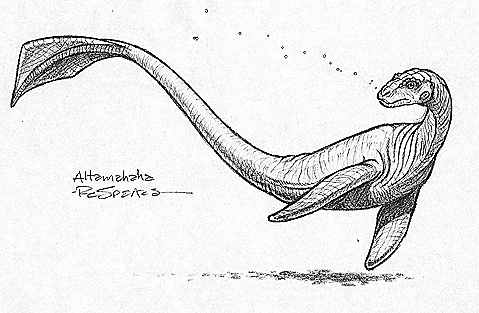
This Altamaha-ha drawing is by D. L. Tanner’s friend, the artist and dinosaur exhibit designer Rick Spears. The artist is known for his illustrations in an award-winning book of 2006:
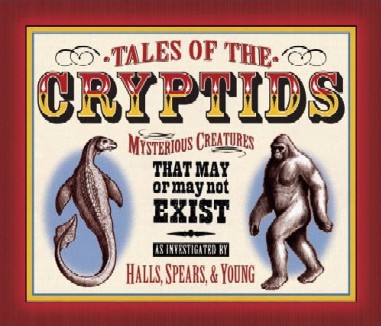
Tales of the Cryptids: Mysterious Creatures That May or May Not Exist by Kelly Milner Halls, Rick Spears, and Roxyanne Young (Columbus, OH: Darby Creek Publishing, 2006). Another version of Altamaha-ha is right there, on the cover!
Altamaha-ha is the star of Dallas Tanner’s third novel in his trilogy, Wake of the Lake Monster.
Tanner’s cryptofiction deals with his vision of Alty’s adventures:
Along the coastal waterways of Georgia’s tidal marshes, there lives a monster that makes the Altamaha River its home. Over 20 feet in length, with a snakelike head atop its long neck, the Altamaha-ha has been sighted dozens of times by those who live along its namesake. A pregnant female struggles to return upriver and give birth. She is bound by those who captured her before, and pursued by others who already killed her mate for where she can lead them. A place marked as the abode of dragons by the Tama Indians, it is also the location of a treasure buried in the final days of the Confederacy. Drawn to the river and caught up in events centuries in the making, Ian becomes the unwitting pawn in a quest for world domination. He soon learns of his link to the Altamaha-ha, and that he must save it, if he is to save himself. Aided only by a few colorful locals, McQuade must defeat the enemies of the Foundation, before its technology is turned into a doomsday device.
Perhaps in Alty, something is to be found that informs the research about Pinky. Certainly, from Spears’ drawing, I can see some elements that seem disjoined in the St. Johns River descriptions but might be explained by the uniqueness of these creatures varied features.
The search for the answers to Pinky and his kin must continue in the future, but for now, I conclude with the wonder of the quest and the patience of the hunt. I enjoyed my time in Florida, and now the hour is at hand to plan my next adventure.
^^^^^^^^^^^
See the next issue of TAPS Paramagazine for more on “Pinky: Florida’s Dinosaur.”
For a summary of all of my “Pinky Expedition” blogs, below are each one, only a click away:
Pinky Report: St. Johns River, Part 1
Pinky Expedition: St. Johns River, Part 2
Pinky Expedition: Dinosaur World
Pinky Expedition: Investigative Breakthrough
Pinky Expedition: High Walking
Pinky Expedition: Manatee Musings

Again, if you want to see an ancient “mermaid” (no doubt, part of the answer to the St. Johns River Monster question), check out the manatees up close at the Blue Springs State Park (shown below) in Orange City, Florida, especially during the cooler months of the year. You haven’t seen the real Florida until you’ve been there.
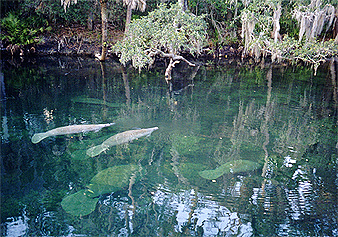
About Loren Coleman
Loren Coleman is one of the world’s leading cryptozoologists, some say “the” leading living cryptozoologist. Certainly, he is acknowledged as the current living American researcher and writer who has most popularized cryptozoology in the late 20th and early 21st centuries.
Starting his fieldwork and investigations in 1960, after traveling and trekking extensively in pursuit of cryptozoological mysteries, Coleman began writing to share his experiences in 1969. An honorary member of Ivan T. Sanderson’s Society for the Investigation of the Unexplained in the 1970s, Coleman has been bestowed with similar honorary memberships of the North Idaho College Cryptozoology Club in 1983, and in subsequent years, that of the British Columbia Scientific Cryptozoology Club, CryptoSafari International, and other international organizations. He was also a Life Member and Benefactor of the International Society of Cryptozoology (now-defunct).
Loren Coleman’s daily blog, as a member of the Cryptomundo Team, served as an ongoing avenue of communication for the ever-growing body of cryptozoo news from 2005 through 2013. He returned as an infrequent contributor beginning Halloween week of 2015.
Coleman is the founder in 2003, and current director of the International Cryptozoology Museum in Portland, Maine.
Filed under Books, Breaking News, Cryptofiction, Cryptomundo Exclusive, Cryptotourism, CryptoZoo News, Cryptozoologists, Cryptozoology, Expedition Reports, Eyewitness Accounts, Folklore, Lake Monsters, Living Dinosaurs, Mokele-Mbembe, Sea Serpents, Swamp Monsters